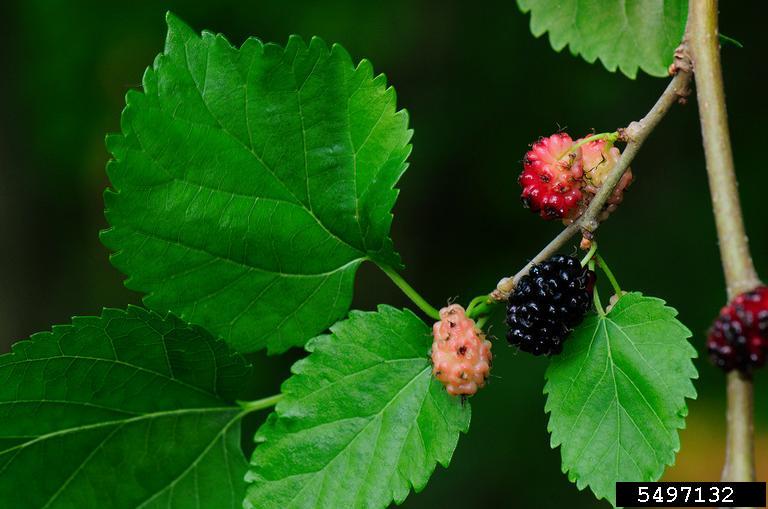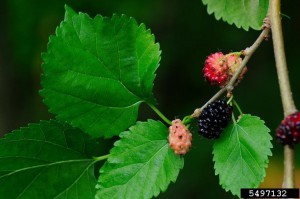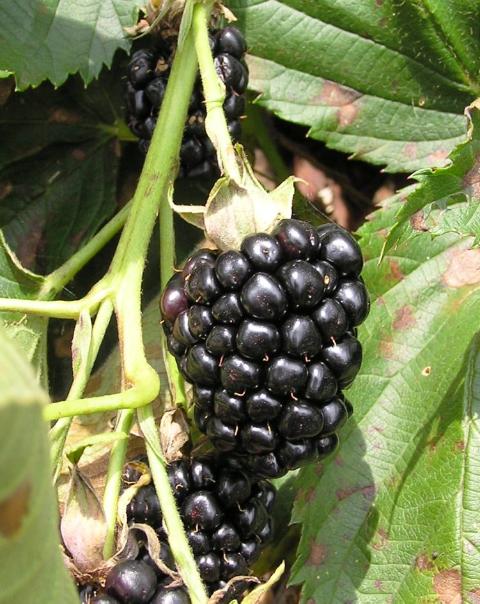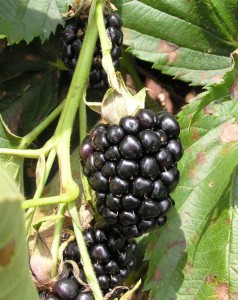
by Larry Williams | Jul 7, 2015
There are a number of plants in my landscape that bring back fond memories – plants that I propagated.

Red Mulberry. Photo credit: Vern Williams, Indiana University, bugwood.org.
There’s a mulberry tree in my backyard that I rooted years ago. I took the cuttings from an old mulberry tree in my hometown. As a boy, I climbed the tree, got in trouble once for coming home with mulberry stains on my clothes. I liked the berries and still do. I have good childhood memories about the tree.
About twenty years ago I visited the property adjacent to my childhood home. The tree was still there. It was during mulberry season. I enjoyed a few mulberries. I took about eight or ten cuttings from the tree. About a year after my visit, the property sold. The new owner bulldozed the tree.
But because of the cuttings that I rooted, the tree still lives and not just in my memory. The trees produced by those cuttings are genetically the same as the parent tree. Essentially, they are clones. The one in my backyard produces mulberries each year.
You too can propagate memories. Not all plants can be propagated from cuttings but many can be. Sometimes trial and error is necessary to learn proper timing in taking cuttings. But most reliable references will provide the time of year to take cuttings based on the plant species.
Stem cuttings should be removed from the parent plant with a clean, sharp knife or pruner. Ideally your cutting should be 4-6 inches in length and not much thicker than a pencil in diameter.
Take the bottom two-thirds of leaves off on each cutting. The cuttings should be stuck upright in a propagation medium. I usually use a good quality potting mix and mix in a little course sand or perlite for better drainage. The cuttings should be inserted deep enough to hold them upright, usually ½ to 1 inch.
To help promote rooting of moderate to difficult to root plants, wound the cuttings by scraping the lower ½ to 1 inch of the stem with a clean, sharp knife. The scrape should remove the bark or “skin.” Then dip the cutting in a rooting hormone covering the scrape with the rooting powder prior to inserting the cutting into the rooting medium.
I usually use a four inch pot, gallon size pot or bedding plant flat with drainage holes as a rooting container. I may stick as many as ten stem cuttings in a gallon size pot. I place the container of cuttings in a shady location outdoors and keep it moist. The cuttings should produce roots in two to sixteen weeks, depending upon plant species and the environment.
After the cuttings have rooted, carefully remove them and individually plant each rooted cutting in its own four inch to one gallon size pot. Keep the potting medium moist but not soggy. After the roots adequately fill the pot, the plant should be strong enough to be planted in the ground.
As your rooted cuttings grow, hopefully they will provide fond memories.

by Eddie Powell | Feb 25, 2014
As you begin plans for your garden this spring think about creating an edible landscape. Edible landscaping is becoming more popular now that vegetable prices are increasing.

Edible landscapes are attractive to the eye, as well as enticing to the palate. What more could a home gardener ask for than to be walking through the landscape eating vegetables and fruits produced from their very own effort? The additional color edible landscapes offer is a bonus.
Locating the edible landscape in the right spot is important. Make sure it is planted in an area that will be easily accessible and visible. It is fun and rewarding to watch vegetables grow and work in the garden.
One of the numerous benefits of edible landscape gardening includes obtaining freshly picked produce on a regular basis. Such freshness offers higher nutritional value and enhanced flavor, since produce is at its highest peak right after harvest. This is a benefit because most vegetables sold through large supermarkets have been stored and transported for days or weeks, depending on the product.
Food costs have been on the rise due to rising fuel and fertilizer prices, increasing regulations and competition from imported produce. By creating an edible landscape, the home gardener can reduce their food costs. As a bonus, fresh food will be right outside!
Read more on this topic by visiting the UF IFAS edible landscaping page
by Alex Bolques | Oct 25, 2013
 The avid gardener has heard on many occasions that fall is the best time of the year to plant trees and shrubs. Correct! Now is the time to start a fruit orchard or an edible landscape. As the seasons transition into much cooler weather, now is the ideal planting season for hardy trees, shrubs and ground covers (Trawick, 2013).
The avid gardener has heard on many occasions that fall is the best time of the year to plant trees and shrubs. Correct! Now is the time to start a fruit orchard or an edible landscape. As the seasons transition into much cooler weather, now is the ideal planting season for hardy trees, shrubs and ground covers (Trawick, 2013).
In the fall, plants require less water to get established and stress factors associated with planting in full sun are reduced. Although weather is cool, soil temperatures continue to be warm enough throughout the season to promote root growth. Thus by planting in the fall, the plant becomes more established by having a better and more vigorous root system than a plant that is planted at springtime.
Deciding what to grow sometimes is limited by what is available in a given area. Mail and online sales can be tricky if for those unaware about which fruit species perofrms best in Northwest Florida. To aid in this planning process, a link to a University of Florida IFAS publication (HS1218) is included that contains a directory of certified Florida nurseries offering fruit and nut crops. While it was developed to assist farmers locate fruit and nuts cultivars in Florida, it is helpful to begin thinking about what to grow and where to find it. The publication also lists recommended fruit and nut species and cultivars for North Florida, including north-central Florida.
Fruitscapes is a University of Florida website dedicated to fruit trees in Florida, which will increase understanding of fruit tree cultural and pest management requirements for all readers. Also explore “Temperate Fruit Crops” . Bookmark this webpage and refer to it as needed. Also, consult with your county extension office in your area.





